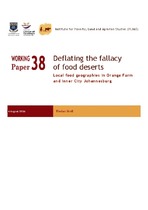| dc.contributor.author | Kroll, Florian | |
| dc.date.accessioned | 2019-03-14T10:58:39Z | |
| dc.date.available | 2019-03-14T10:58:39Z | |
| dc.date.issued | 2016-08 | |
| dc.identifier.citation | Kroll, F. 2016. Deflating the fallacy of food deserts: Local food geographies in Orange Farm and Inner City Johannesburg, Working Paper 38. Cape Town: PLAAS, UWC and Centre of Excellence on Food Security. | en_US |
| dc.identifier.uri | http://hdl.handle.net/10566/4516 | |
| dc.description.abstract | The availability and accessibility of food is constrained by the environments where people live, work and
purchase goods, and the pathways which they use to traverse these. This recognition has given rise to
innovative conceptual frameworks including “food environments” and “food deserts”. These concepts add
a spatial dimension to food security research that could inform food systems governance. Although the
concepts have expanded the understanding of food security in the global North, their application to the
South African context, and to value chains analysis, is still in its infancy. This paper introduces these
frameworks and considers their utility in South African cities. The paper presents recent data emerging
from case studies of local food geographies conducted by the African Food Security Urban Network
(AFSUN). This research proceeded from recognising the importance of informal retail in South African
urban food systems. The case studies mapped formal sector food retail outlets in urban Johannesburg,
correlating these with socio-economic data. Informal food processing and trade were also mapped in
smaller research areas to explore food prevalence and diversity in the local geography and map the
spatial patterns of informal food outlets. These studies reveal that the distribution of supermarkets
entrenches spatial inequalities and constrains access to food distributed through formal value chains.
The studies also reveal spatial and temporal patterns of informal food retail, which provides diverse food
retail outlets clustered around public transport access points, along high traffic pedestrian routes, and
distributed throughout residential spaces. Although healthy foods are available, unhealthy foods and
risky food environments are pervasive. These findings confirm that the concept of food deserts fails to
reflect the diversity of food available and accessible through informal livelihoods and suggests that scalar
network models of food geographies offer better conceptual frameworks. | en_US |
| dc.language.iso | en | en_US |
| dc.publisher | Institute for Poverty, Land and Agrarian Studies, University of the Western Cape | en_US |
| dc.relation.ispartofseries | Working Paper;38 | |
| dc.subject | Food environments | en_US |
| dc.subject | Food deserts | en_US |
| dc.subject | Informal trade | en_US |
| dc.subject | Supermarkets | en_US |
| dc.title | Deflating the fallacy of food deserts: Local food geographies in Orange Farm and inner city Johannesburg | en_US |
| dc.type | Working Paper | en_US |

